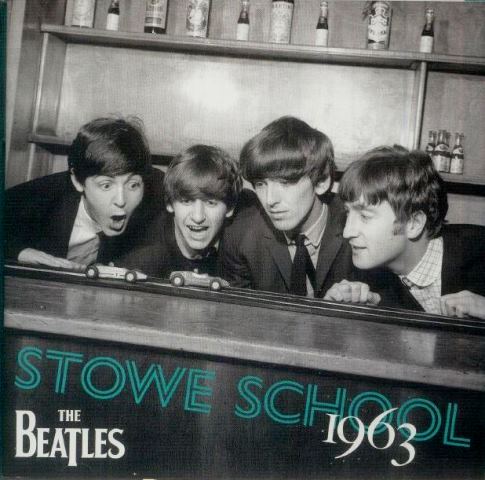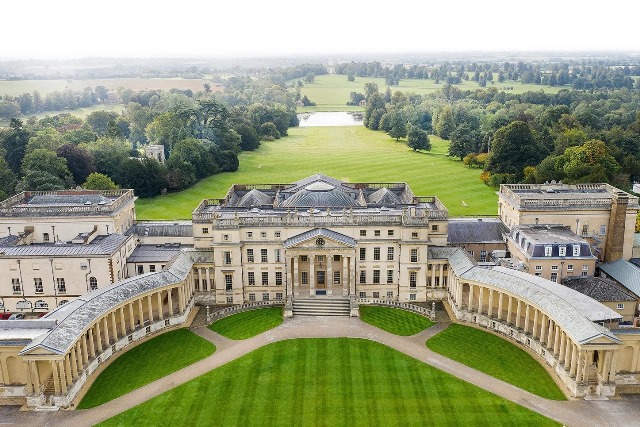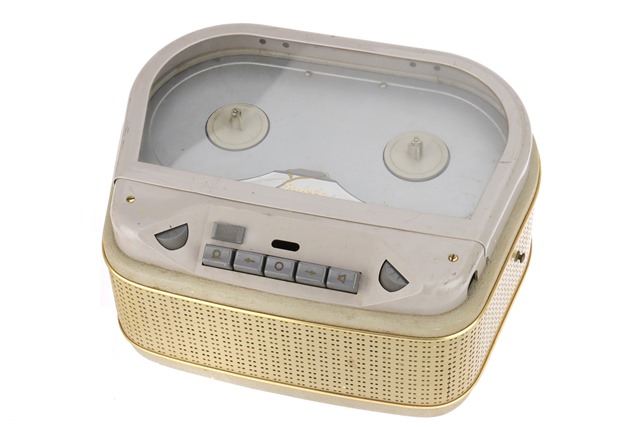“We hope if you like it, you'll buy it,” says Paul McCartney. It’s 4 April 1963 and The Beatles are on stage and about to perform their third single “From Me to You.” It’s out in a week.
To his left, John Lennon instantly responds to the entreaty. “And if you don't like it,” he retorts. “Don't buy it.”
 This atypical approach to promotion was witnessed by the audience gathered in the Roxburgh Hall of Stowe School, a Buckinghamshire all-boys institution hosting a late afternoon concert nominated as “probably The Beatles most unusual live gig” by the foremost Beatles scholar Mark Lewisohn before the surprise emergence of a recording of the show. The “don’t buy it” comeback was previously unknown.
This atypical approach to promotion was witnessed by the audience gathered in the Roxburgh Hall of Stowe School, a Buckinghamshire all-boys institution hosting a late afternoon concert nominated as “probably The Beatles most unusual live gig” by the foremost Beatles scholar Mark Lewisohn before the surprise emergence of a recording of the show. The “don’t buy it” comeback was previously unknown.
This extraordinary, historically significant recording is the earliest full Beatles show from the UK to have emerged. Sandwiched between the release of debut album Please Please Me and “From Me to You,” it catches the band as they bulldozed their way into the national consciousness. The album was a best seller, as was its preceding single “Please Please me.” The word was out. There had been two recent national TV appearances, each on ABC’s Thank Your Lucky Stars in January and February. Specially taped appearances on BBC radio were increasingly frequent: the morning of the Stowe concert, they taped tracks for Side By Side, broadcast on 24 June. The day after the Roxburgh Hall appearance, they were at EMI’s London headquarters to receive silver discs – their first – for the “Please Please me” single, a ceremony at which they played a couple of songs. That evening, a show at east London’s Leyton Swimming Baths.
Knowledge of this mind-boggling live recording? None, until the BBC's Samira Ahmed began looking into the Stowe show
The Stowe booking came about when a pupil at the school, David Moores – from Liverpool and later chairman of Liverpool FC, he was a member of the prominent family which owned Littlewoods football pools – wrote to the Beatles’ manager Brian Epstein in January 1963 to enquire if the band would play the school. Despite their increasing success and the draws on their time, Epstein agreed to the booking. He wrote back “It would be a great pleasure for the boys to appear at Stowe, but I must advise you they are heavily booked and I can’t make much allowance with regard to their fee.” Epstein quoted £100 in his letter. Moores confirmed – and after a little hiccup when Epstein asked for someone over 21 to sign the contract – the 240 tickets were sold at 10 shillings each. In comparison, a 7 March show, in Nottingham and for the public, had a ticket price of 6s and 6d. The relatively pricey Stowe performance was planned for 5.30pm that April Thursday.
That would have been it, an oddity in the Beatles calendar, a show performed at a public school (i.e. a private school) just under two weeks after the release of their first album Please Please Me and a week before their third single, “From Me to You,” was in shops. The band had just completed a UK tour with Chris Montez and Tommy Roe where they weren’t the headliner. Nonetheless, they were on the up. At Stowe, this was confirmed by the presence of photographer David Magnus. Now, the recording.
 Just under 60 years on from the show, the BBC’s Samira Ahmed – a big Beatles fan – was on holiday in 2022 and given a chance to visit Stowe School. While there, she noticed a plaque commemorating The Beatles concert and thought an item on Front Row, the Radio 4 arts show she hosts, would be good. As she later put it in The Journal of Beatles Studies, “I knew there had to be a story in this fascinating collision of class, cultural taste and an all-male audience, at that moment before the Beatles burst fully on to the world stage.” (pictured left, Stowe School)
Just under 60 years on from the show, the BBC’s Samira Ahmed – a big Beatles fan – was on holiday in 2022 and given a chance to visit Stowe School. While there, she noticed a plaque commemorating The Beatles concert and thought an item on Front Row, the Radio 4 arts show she hosts, would be good. As she later put it in The Journal of Beatles Studies, “I knew there had to be a story in this fascinating collision of class, cultural taste and an all-male audience, at that moment before the Beatles burst fully on to the world stage.” (pictured left, Stowe School)
After Ahmed was put in touch with some old pupils a twist emerged. David Moores had recently passed way, but there were hints the concert had been recorded. John Bloomfield, aged 15 then, had indeed taped it on a Butoba MT5 recorder which ran on 12 batteries. He used a reel of BASF tape and fixed a microphone to the front of the stage. He still had the recording. Its materialisation from nowhere is astonishing. Mark Lewisohn was contacted. A tape of a post-show interview had circulated. But knowledge of this mind-boggling live tape? None, until Samira Ahmed began looking into the Stowe show. National news coverage – as well as the Front Row piece – followed.
Brian Epstein had booked the band to play two half-hour sets. They arrived late, so played one long set. The tape catches 22 songs – digging has found that they performed 24: the tape ran out, so “Sweet Little Sixteen” and "Long Tall sally” were not recorded. Both sides of the forthcoming "From Me to You"/"Thank You Girl" single are played: up 10th and 11th. “Baby It’s You,” “Chains,” “Do You Want to Know a Secret” “P.S. I Love You” and “There’s a Place” from the Please Please Me LP are not heard. George Harrison had lost his voice, which maybe explains some of the omissions. Also, Billy J. Kramer’s version of Lennon and McCartney’s “Do You Want to Know a Secret” was heading up the charts at this time, perhaps a reason to shy away from the song in a live setting.
The Beatles were The Beatles, wherever and to whomever they were playing
Expectedly, while Paul McCartney’s stage banter is agreeable, polite, upbeat, John Lennon’s is often acerbic. When they play “Some Other Guy” – not one of their own songs – Paul McCartney mentions the Big Three’s single version. Cue a “boo” from Lennon. The Beatles were The Beatles, wherever and to whomever they were playing.
What did change at Stowe though was how they approached what was being played. The ad hoc nature of the long set is acknowledged 40 minutes in, after “Twist and Shout.” “As you may have noticed,” says McCartney. “This is a bit unrehearsed, we thought we'd be doing two half-hour spots.” Requests shouted from the audience are played: “Anna,” “Please Please me.” Following “Ask me Why,” McCartney goes all the way by asking “Any requests?” A shouted “How do You do it” is ignored.
 Despite the increasingly off-the-cuff nature of the performance, the band and are as hard and tight at the end as are at the beginning when they open with “I Saw Her Standing There.” This is only just-over three months after they completed their last run at Hamburg's Star Club. So far in 1963, they had two national UK tours under their belt. There were one-nighters too. They were drilled, their playing verging on the autonomic. Bam, off they go. Nothing like this had been heard and seen before. A noteworthy diversion at Stowe is the version of Ann-Margaret’s waltz-time “I Just Don't Understand” which, until this point, was only known from when it was recorded for one of their Pop Goes The Beatles radio shows in July 1963. Before playing it, Lennon remarks “We'd like to do one we haven't done for a bit, cos we don't usually play this long.” (pictured right, a Butoba MT5 tape recorder like the one which recorded the Stowe concert)
Despite the increasingly off-the-cuff nature of the performance, the band and are as hard and tight at the end as are at the beginning when they open with “I Saw Her Standing There.” This is only just-over three months after they completed their last run at Hamburg's Star Club. So far in 1963, they had two national UK tours under their belt. There were one-nighters too. They were drilled, their playing verging on the autonomic. Bam, off they go. Nothing like this had been heard and seen before. A noteworthy diversion at Stowe is the version of Ann-Margaret’s waltz-time “I Just Don't Understand” which, until this point, was only known from when it was recorded for one of their Pop Goes The Beatles radio shows in July 1963. Before playing it, Lennon remarks “We'd like to do one we haven't done for a bit, cos we don't usually play this long.” (pictured right, a Butoba MT5 tape recorder like the one which recorded the Stowe concert)
Then, add in the audience reaction to this transfixing experience. Clearly, the songs which had been issued were already embedded for those seated in the school's theatre. Songs begin, there’s an instant cheer. Even for the yet-to-be released “From Me to You” and “Thank You Girl." At the end of song two, “Too Much Monkey Business,” the response is audible but understated – there is no between-song hubbub although a static-like current in the air is detectable (no, not tape hiss). However, there is a change between “Anna” – 16th up – and “Please Please me.” What seems to be screaming during occurs the latter and thereafter. Some staff of the school have come in to the hall, along with their daughters. Even so, the show is no scream-fest.
The only caveat with this extraordinary artefact is that – unsurprisingly – the sound quality isn’t fantastic. As a benchmark, it’s a step below The Velvet Underground’s Max’s Kansas City album. A bootleggers B+. Everything is audible, even the on-stage speech which the microphone strains to capture. The recording is not muffled but there is a distance and some distortion on loud passages like the “Hippy Hippy Shake” guitar solo. None of this matters. The Stowe School recording is mandatory listening.
- Next week: The five CDs of Moving Away From The Pulsebeat - Post-Punk Britain 1977-1981
- More reissue reviews on theartsdesk
- Kieron Tyler’s website















Add comment